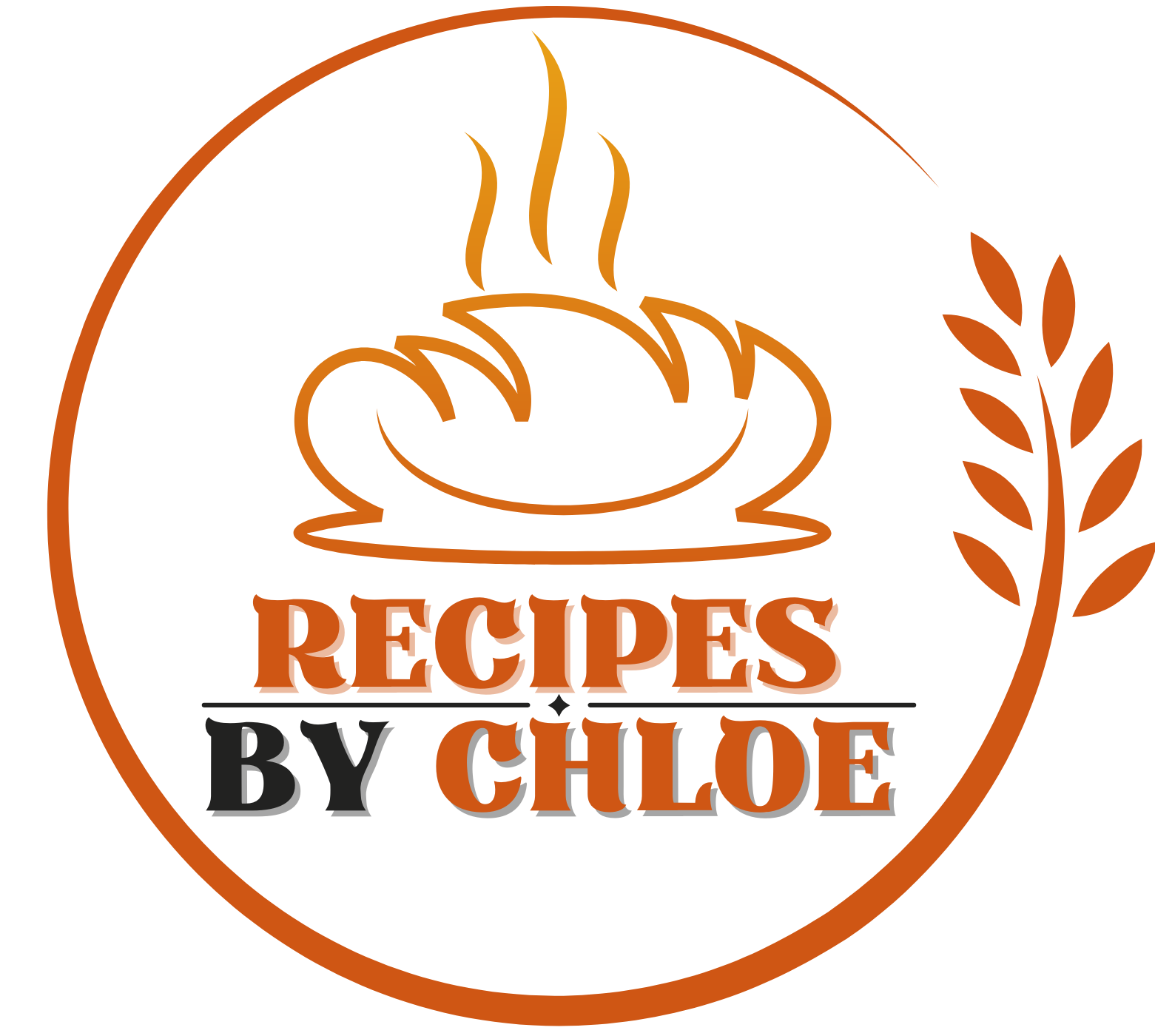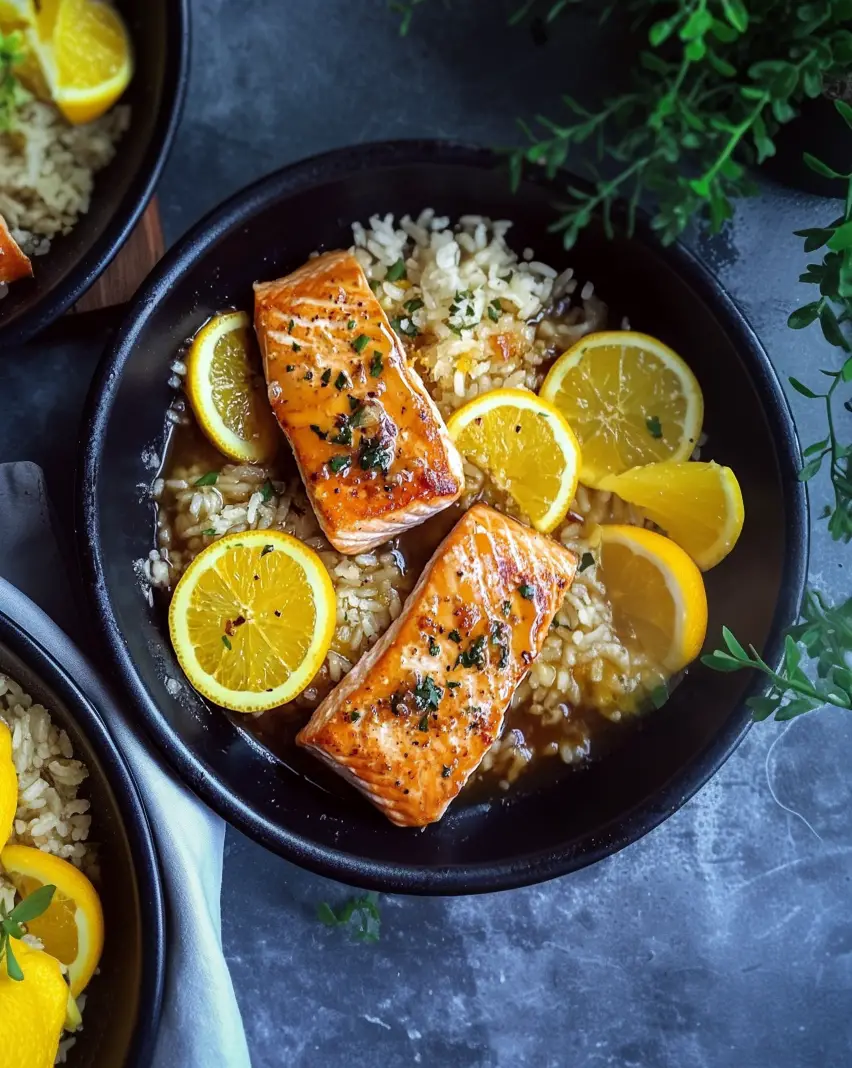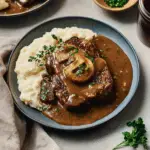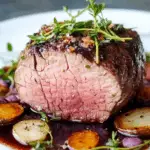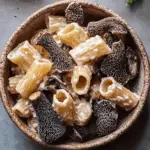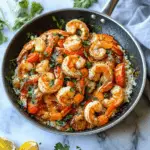Orange Glazed Salmon is a quick and easy, family-friendly dinner recipe. This sweet and savory seafood dish requires just 5 ingredients and 15 minutes to prepare.
Full Recipe:
Ingredients
- 1 pound salmon fillets
- 1 tablespoon butter (or olive oil)
- 1/2 cup fresh orange juice (from approximately 1 orange)
- 2 tablespoons honey
- 2 tablespoons soy sauce
- 2 cloves garlic, minced
- 1 teaspoon cornstarch whisked with 1 teaspoon water (optional, for a thicker glaze)
- Salt and pepper, to taste
Directions
- Mince the garlic and juice the orange. If desired, slice additional orange rounds for garnish.
- Heat butter or olive oil in a large skillet over medium-high heat.
- Season salmon fillets with salt and pepper. Place them skin-side up in the skillet and cook for 3–5 minutes until golden brown. Flip and cook for another 3–4 minutes, or until the internal temperature reaches 145°F (63°C).
- Remove the salmon from the skillet and tent with foil to keep warm. Reduce heat to medium.
- In a bowl, whisk together orange juice, honey, soy sauce, minced garlic, and cornstarch slurry (if using).
- Pour the mixture into the same skillet and cook until hot. If using cornstarch, the glaze will thicken in about 30–60 seconds.
- Return the salmon to the pan and coat with the glaze. Garnish with fresh parsley or orange slices if desired.
- Serve warm.
Nutrients
Per serving (based on 4 servings):
- Calories: 242 kcal
- Protein: 24 g
- Fat: 10 g
- Carbohydrates: 13 g
- Sugar: 11 g
- Sodium: 554 mg
- Cholesterol: 70 mg
- Potassium: 649 mg
- Vitamin C: 16 mg
- Calcium: 23 mg
- Iron: 1 mg
Health Benefits of Salmon
Salmon is widely regarded as one of the healthiest fish to include in your diet. It is an excellent source of high-quality protein and omega-3 fatty acids, which are essential for heart health, brain function, and reducing inflammation. Omega-3 fatty acids, particularly EPA and DHA, help lower blood pressure, reduce the risk of heart disease, and support mental health. Incorporating salmon into your meals regularly can promote overall well-being and provide essential nutrients that may be lacking in other protein sources.
Additionally, salmon is rich in B vitamins, including B12, niacin, and B6, which are crucial for energy production, brain health, and the formation of red blood cells. It also provides important minerals such as selenium, potassium, and phosphorus, contributing to immune function, electrolyte balance, and bone health. Eating salmon with a fresh citrus glaze adds vitamin C from the orange juice, further boosting the nutritional value of the dish.
Why Orange Glaze Works So Well
The orange glaze is the heart of this recipe. It provides a vibrant, sweet, and tangy flavor that complements the natural richness of the salmon. The sweetness of honey balances the acidity of the orange juice, while the soy sauce adds depth and a subtle umami quality that elevates the dish beyond a simple sweet glaze.
This combination of ingredients is versatile and works well because it engages multiple taste sensations—sweet, salty, tangy, and savory. The garlic in the glaze adds an aromatic pungency, which rounds out the flavor and keeps it interesting. When cooked, the glaze thickens and caramelizes slightly, creating a beautiful, sticky coating that enhances the texture and appearance of the salmon.
Cooking Tips for Perfect Orange Glazed Salmon
To achieve the best results with this recipe, choosing the right salmon is key. Fresh, wild-caught salmon tends to have better flavor and texture compared to farmed varieties, though either can be used depending on availability and budget. Make sure your salmon fillets are of even thickness to ensure uniform cooking.
Cooking salmon skin-side up first helps render some of the fat and creates a crispier texture on the skin if you leave it on. Using medium-high heat allows the salmon to cook quickly while developing a nicely seared exterior without drying out. Resting the salmon after cooking is important as it allows the juices to redistribute, keeping the fillet moist and tender.
When preparing the glaze, whisking the cornstarch slurry into the sauce is optional but recommended if you prefer a thicker, more clingy glaze. Be sure to monitor the glaze carefully to prevent it from burning, as the sugars in honey and orange juice can caramelize quickly.
Serving Suggestions and Pairings
Orange glazed salmon pairs beautifully with a variety of side dishes, making it a versatile option for dinner. For a light and fresh accompaniment, serve it alongside a crisp green salad with a citrus vinaigrette to echo the flavors of the glaze. Steamed or roasted vegetables such as asparagus, green beans, or broccoli also complement the dish well.
For a heartier meal, consider serving the salmon with rice pilaf, quinoa, or garlic mashed potatoes. These starches help soak up the extra glaze and balance the meal nutritionally. Additionally, a side of sautéed mushrooms or a medley of roasted root vegetables adds an earthy contrast to the bright and sweet salmon.
Pairing this dish with a light, fruity white wine such as Sauvignon Blanc or Pinot Grigio enhances the citrus notes and cleanses the palate between bites. Non-alcoholic options like sparkling water with a splash of fresh orange juice or a ginger-lemongrass iced tea make refreshing accompaniments.
Cultural and Culinary Context
Citrus-glazed fish dishes are found in many cuisines worldwide, often prized for their ability to brighten and elevate the natural flavors of seafood. The use of orange in cooking is common in Mediterranean, Asian, and American cuisines, where citrus is valued for its freshness and ability to cut through rich, oily foods.
This particular recipe combines elements inspired by Asian cooking—such as soy sauce and garlic—with classic Western notions of glazing and roasting fish. It’s a fusion that speaks to the versatility of salmon as an ingredient and the global influence on modern home cooking.
Variations to Try
While the classic orange glaze is delicious as is, there are several ways you can customize this recipe to suit your taste or dietary preferences. For a spicy kick, add a pinch of red pepper flakes or a splash of sriracha to the glaze. If you prefer a more herbal profile, incorporating fresh ginger or chopped cilantro can bring a fresh twist.
For those who need a low-sodium option, substitute low-sodium soy sauce or tamari. You can also experiment with other citrus juices such as blood orange, tangerine, or lemon for different flavor nuances. To make it a complete meal, try serving the salmon on a bed of wilted spinach or kale sautéed with garlic and a squeeze of fresh orange juice.
Sustainability Considerations
When choosing salmon for this recipe, consider the sustainability of your purchase. Wild-caught Alaskan salmon is often recommended as a more sustainable choice due to strict regulations on fishing practices. Farmed salmon, while more widely available and often more affordable, can have environmental and ethical concerns depending on farming methods.
Conclusion
Orange glazed salmon is an outstanding dish that combines health benefits, ease of preparation, and exquisite flavor into one delightful package. Its quick cooking time and minimal ingredient list make it ideal for busy weeknights, yet it’s elegant enough to impress guests. Rich in omega-3 fatty acids and packed with vitamins and minerals, salmon is a nutritional powerhouse, while the orange glaze adds a burst of flavor that enlivens the palate.
